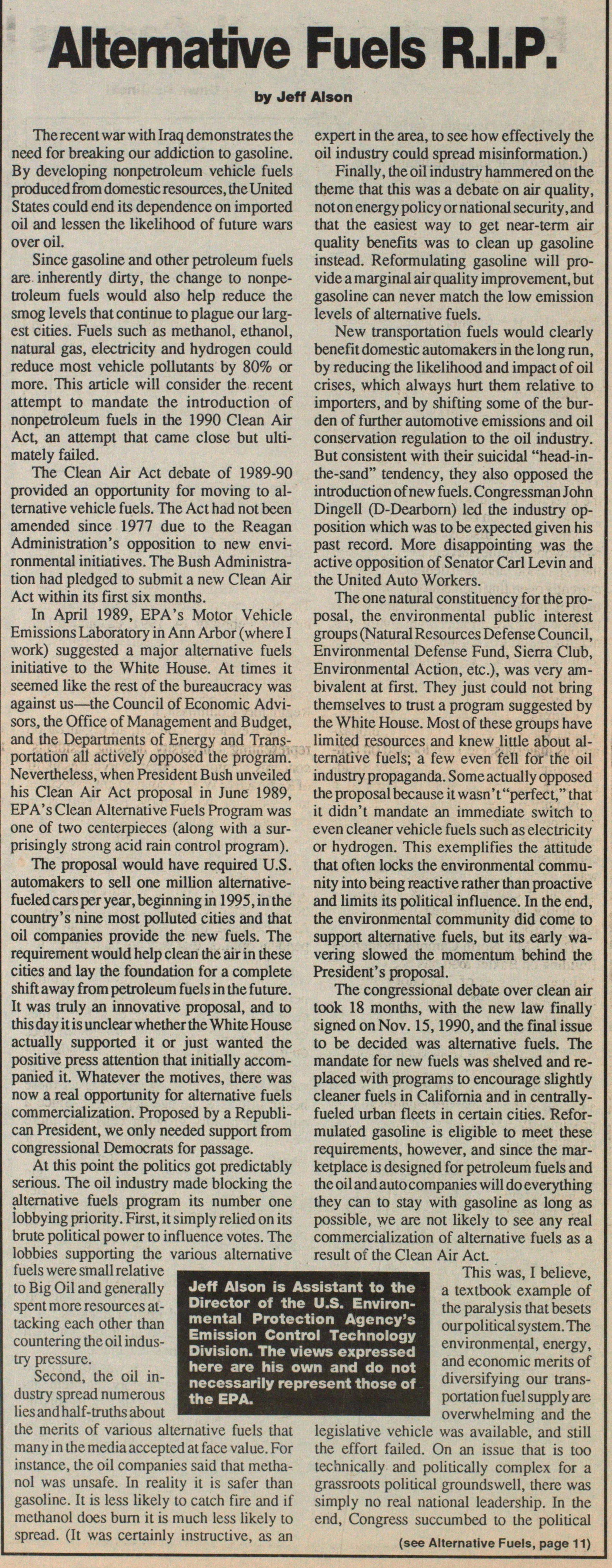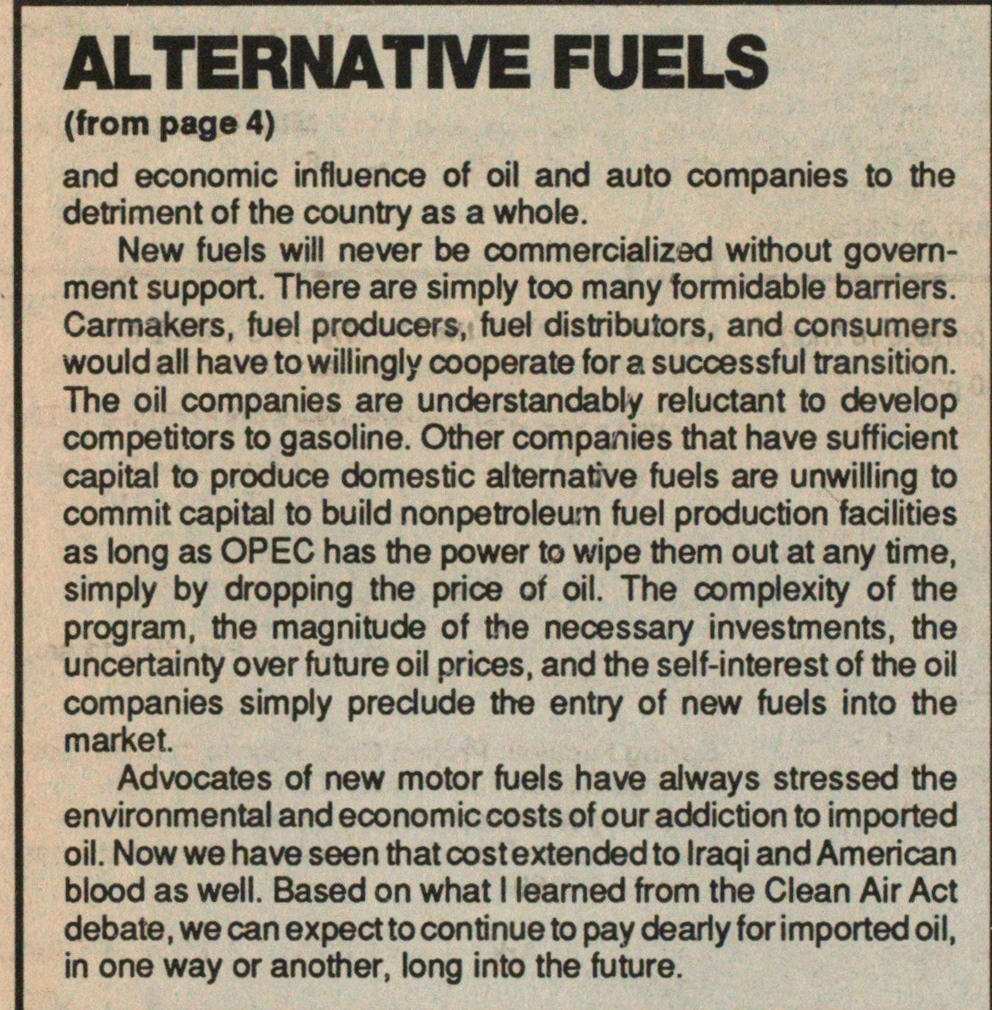Alternative Fuels R.i.p.


The recent war with Iraq demonstrates the need for breaking our addiction to gasoline. By developing nonpetroleum vehicle fuels produced from domestic resources, the United States could end its dependence on imported oil and lessen the likelihood of future wars over oil.
Since gasoline and other petroleum fuels are inherently dirty, the change to nonpetroleum fuels would also help reduce the smog levels that continue to plague our largest cities. Fuels such as methanol, ethanol, natural gas, electricity and hydrogen could reduce most vehicle pollutants by 80% or more. This article will consider the recent attempt to mandate the introduction of nonpetroleum fuels in the 1990 Clean Air Act, an attempt that came close but ultimately failed.
The Clean Air Act debate of 1989-90 provided an opportunity for moving to alternative vehicle fuels. The Act had not been amended since 1977 due to the Reagan Administration's opposition to new environmental initiatives. The Bush Administration had pledged to submit a new Clean Air Act within its first six months.
In April 1989, EPA's Motor Vehicle Emissions Laboratory in Ann Arbor (where I work) suggested a major alternative fuels initiative to the White House. At times it seemed like the rest of the bureaucracy was against us - the Council of Economic Advisors, the Office of Management and Budget, and the Departments of Energy and Transportation all actively opposed the program. Nevertheless, when President Bush unveiled his Clean Air Act proposal in June 1989, EPA's Clean Alternative Fuels Program was one of two centerpieces (along with a surprisingly strong acid rain control program).
The proposal would have required U.S. automakers to sell one million alternative-fueled cars per year, beginning in 1995, in the country's nine most polluted cities and that oil companies provide the new fuels. The requirement would help clean the air in these cities and lay the foundation for a complete shift away from petroleum fuels in the future. It was truly an innovative proposal, and to this day it is unclear whether the White House actually supported it or just wanted the positive press attention that initially accompanied it. Whatever the motives, there was now a real opportunity for alternative fuels commercialization. Proposed by a Republican President, we only needed support from congressional Democrats for passage.
At this point the politics got predictably serious. The oil industry made blocking the alternative fuels program its number one lobbying priority. First, it simply relied on its brute political power to influence votes. The lobbies supporting the various alternative fuels were small relative to Big Oil and generally spent more resources attacking each other than countering the oil industry pressure.
Second, the oil industry spread numerous lies and half-truths about the merits of various alternative fuels that many in the media accepted at face value. For instance, the oil companies said that methanol was unsafe. In reality it is safer than gasoline. It is less likely to catch fire and if methanol does burn it is much less likely to spread. (It was certainly instructive, as an expert in the area, to see how effectively the oil industry could spread misinformation.)
Finally, the oil industry hammered on the theme that this was a debate on air quality, not on energy policy or national security, and that the easiest way to get near-term air quality benefits was to clean up gasoline instead. Reformulating gasoline will provide a marginal air quality improvement, but gasoline can never match the low emission levels of alternative fuels.
New transportation fuels would clearly benefit domestic automakers in the long run, by reducing the likelihood and impact of oil crises, which always hurt them relative to importers, and by shifting some of the burden of further automotive emissions and oil conservation regulation to the oil industry. But consistent with their suicidal "head-in-the-sand" tendency, they also opposed the introduction of new fuels. Congressman John Dingell (D-Dearborn) led the industry opposition which was to be expected given his past record. More disappointing was the active opposition of Senator Carl Levin and the United Auto Workers.
The one natural constituency for the proposal, the environmental public interest groups (Natural Resources Defense Council, Environmental Defense Fund, Sierra Club, Environmental Action, etc), was very ambivalent at first. They just could not bring themselves to trust a program suggested by the White House. Most of these groups have limited resources and knew little about alternative fuels; a few even fell for the oil industry propaganda. Some actually opposed the proposal because it wasn't "perfect," that it didn't mandate an immediate switch to even cleaner vehicle fuels such as electricity or hydrogen. This exemplifies the attitude that often locks the environmental community into being reactive rather than proactive and limits its political influence. In the end, the environmental community did come to support alternative fuels, but its early wavering slowed the momentum behind the President's proposal.
The congressional debate over clean air took 18 months, with the new law finally signed on Nov. 15, 1990, and the final issue to be decided was alternative fuels. The mandate for new fuels was shelved and replaced with programs to encourage slightly cleaner fuels in California and in centrally-fueled urban fleets in certain cities. Reformulated gasoline is eligible to meet these requirements, however, and since the marketplace is designed for petroleum fuels and the oil and auto companies will do everything they can to stay with gasoline as long as possible, we are not likely to see any real commercialization of alternative fuels as a result of the Clean Air Act.
This was, I believe, a textbook example of the paralysis that besets our political system. The environmental, energy, and economic merits of diversifying our transportation fuel supply are overwhelming and the legislative vehicle was available, and still the effort failed. On an issue that is too technically and politically complex for a grassroots political groundswell, there was simply no real national leadership. In the end, Congress succumbed to the political and economic influence of oil and auto companies to the detriment of the country as a whole.
New fuels will never be commercialized without government support. There are simply too many formidable barriers. Carmakers, fuel producers, fuel distributors, and consumers would all have to willingly cooperate for a successful transition. The oil companies are understandably reluctant to develop competitors to gasoline. Other companies that have sufficient capital to produce domestic alternative fuels are unwilling to commit capital to build nonpetroleum fuel production facilities as long as OPEC has the power to wipe them out at any time, simply by dropping the price of oil. The complexity of the program, the magnitude of the necessary investments, the uncertainty over future oil prices, and the self-interest of the oil companies simply preclude the entry of new fuels into the market.
Advocates of new motor fuels have always stressed the environmental and economic costs of our addiction to imported oil. Now we have seen that cost extended to Iraqi and American blood as well. Based on what I learned from the Clean Air Act debate, we can expect to continue to pay dearly for imported oil, in one way or another, long into the future.